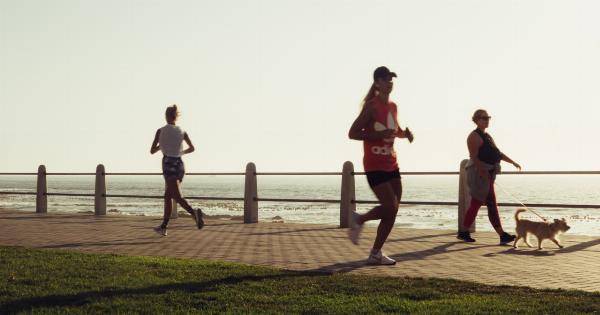After a satisfying dinner, many of us tend to experience the temptation to snack or indulge in unhealthy cravings. Often, this can lead to overeating, impacting our overall health and sleep quality.
However, incorporating some post-dinner exercise into our routine can help manage our appetite while promoting a good night’s sleep. In this article, we will explore the benefits of after-dinner exercise and discuss various workout options ideal for aiding digestion, curbing cravings, and ensuring restful sleep.
1. Benefits of After-Dinner Exercise
Fitting in some exercise after dinner can offer numerous advantages for both our physical and mental well-being. Let’s explore some of these benefits:.
2. Boosting Metabolism
Engaging in physical activity after a meal can significantly boost our metabolism. When we exercise, our body’s demand for energy increases.
This leads to enhanced calorie burning and a faster metabolic rate, allowing us to digest food more efficiently and prevent excessive weight gain.
3. Aiding Digestion
After-dinner exercise can aid digestion by stimulating intestinal contractions and promoting regular bowel movements. Low-impact exercises like walking or yoga can help relieve bloating, reduce gas, and prevent discomfort caused by sluggish digestion.
4. Curbing Late-Night Cravings
One of the primary reasons for weight gain or unhealthy eating habits is late-night snacking. By engaging in exercise after dinner, we are less likely to give in to cravings as our attention shifts towards our physical activity.
Additionally, physical exertion can help regulate appetite hormones, such as ghrelin and leptin, which can further reduce our urge to snack late at night.
5. Reducing Stress and Promoting Relaxation
Exercise is known to be an excellent stress-reliever. By incorporating physical activity into our post-dinner routine, we can effectively manage stress levels and promote relaxation.
This can be particularly beneficial for those who experience work-related stress or have a hectic lifestyle. Reduced stress can contribute to a better night’s sleep and prevent emotional eating.
6. Choosing the Right After-Dinner Exercises
While exercise after dinner can be beneficial, it’s important to opt for activities that are gentle on the body and aid digestion. Let’s discuss some ideal workout options:.
7. Walking
Walking is an excellent low-impact exercise that can be easily incorporated into our routine. Taking a brisk walk after dinner not only helps burn calories but also aids in digestion.
It’s a great way to enjoy some fresh air and spend quality time with family or friends.
8. Yoga
Yoga is a fantastic post-dinner exercise option that not only improves flexibility and strength but also aids digestion and relaxation. Focus on poses that target the abdominal area, such as downward-facing dog, seated forward fold, or spinal twists.
These poses can stimulate digestion and relieve any discomfort.
9. Light Cardio
Engaging in light cardio exercises like cycling, stationary biking, or using an elliptical machine can help raise your heart rate without putting excessive strain on your body. These exercises can aid digestion and promote calorie burning.
10. Strength Training
Incorporating some light strength training exercises into your post-dinner routine can help boost your metabolism and increase muscle mass. Consider using resistance bands, dumbbells, or your body weight for exercises like squats, lunges, or push-ups.
11. Stretching and Relaxation
Stretching after a meal can aid digestion by increasing blood flow to the muscles and promoting relaxation. Focus on gentle stretches that target your core, hips, and lower back.
Additionally, incorporating deep breathing exercises or short meditation sessions can further enhance relaxation and prepare your body for a peaceful sleep.
12. Tips for Effective After-Dinner Exercise
To ensure that your after-dinner exercise routine supports appetite management and good sleep, here are a few helpful tips:.
13. Avoid Intense Workouts
While exercise is crucial, it’s best to avoid high-intensity workouts after dinner. Intense exercises can increase your body temperature and heart rate, making it difficult for you to sleep properly.
Opt for more moderate and gentle workout options instead.
14. Time Your Workout
Try to schedule your workout at least 1-2 hours after dinner to allow ample time for digestion. Exercising immediately after a meal may cause discomfort and disrupt sleep. However, avoiding exercise altogether may also lead to slower digestion.
Finding the right balance is key.
15. Stay Hydrated
Drink enough water during and after your workout to stay hydrated. Water helps in the digestion process and ensures optimal bodily functions. Avoid sugary beverages and opt for plain water or infused water with fruits or herbs for added flavor.
16. Listen to Your Body
Pay attention to how your body feels during and after exercise. If you experience any pain, discomfort, or dizziness, it’s important to stop and consult a healthcare professional.
Adjust the intensity or duration of your workouts according to your fitness level.
17. Wind Down Before Bed
After your workout, make sure to wind down by engaging in relaxing activities like reading a book, listening to calming music, or taking a warm bath.
Avoid stimulating activities like watching television or using electronic devices, as these can interfere with your sleep quality.
18. Conclusion
Incorporating after-dinner exercise into your routine can be a great way to manage your appetite and promote a good night’s sleep.
By choosing gentle exercises, listening to your body, and following the provided tips, you can reap the benefits of exercise while ensuring optimal digestion and relaxation. Remember, consistency is key, so aim to make after-dinner exercise a regular part of your healthy lifestyle.





























